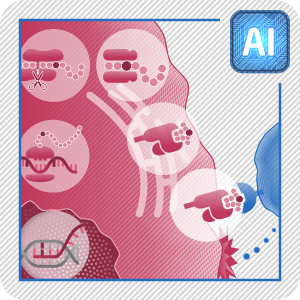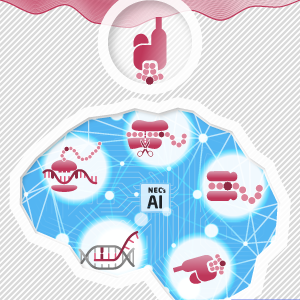Breadcrumb navigation
NEC Immune Profiler
Precision in Every Prediction
The NEC Immune Profiler is a sophisticated software system powered by machine learning algorithms designed to forecast which antigens possess the necessary characteristics to prime T cell immunity, making them viable clinical targets for immunotherapy. Unlike other approaches, NEC Immune Profiler emulates each step of the immune system leading to priming of cellular immunity. The core components of the NEC Immune Profiler, which rely on machine learning, will be explained in detail in the following sections:
1. HLA Binding
The critical step in determining whether an antigen can trigger an immune response is its ability to bind to HLA molecules, because only HLA-bound peptides are recognized by circulating T-cells. The HLA binding module in the NEC Immune Profiler predicts the binding strength of a peptide to specific HLA alleles. This binding strength is quantified by IC50 (nM) scores, where a lower IC50 score signifies a stronger binding affinity between the peptide and the HLA molecule. The module ensembles four distinct binding affinity predictors, to deliver optimal performance.

2. Processing
For an antigen to bind HLA and be displayed on the cell surface, it must first be created through the cleavage of its parent protein by the proteasome in the cytosol and then transported into the endoplasmic reticulum by TAP transporters. The processing module in the NEC Immune Profiler includes several Support Vector Machines (SVM) trained on extensive mass spectrometry immunopeptidome data. These models are integrated into the software as part of an ensemble machine learning layer, consisting of 13 processing models, to predict which antigens possess the right physical and chemical properties to be efficiently processed by the cellular machinery. The module produces a consensus score from 0 to 1, where a score of 1 indicates efficient processing, while a score of 0 indicates poor processing.

3. Antigen Presentation (AP) and Immune Presentation (IP)
For a candidate antigen to activate a T-cell, it must be displayed on the tumor's surface bound to an HLA molecule. The key factors influencing this process include: (1) the binding strength between the antigen and a specific HLA molecule, (2) its efficiency in being processed by the antigen-processing machinery, (3) the expression level of the protein containing the mutation, and (4) the ability of the source protein to provide peptides to the antigen-processing pathway. The IP method calculates a distance measure that assesses the relative uniqueness of candidate antigens, which, when combined with the AP score, generates an immune presentation (IP) score. The AP and IP models complete the holistic approach to neoantigen prediction, championed by the NEC Immune Profiler.

4. Likelihood of TCR recognition
The last determining step of priming a T cell response is the existence in the patient T cell repertoire of clones with a T cell receptor (TCR) having sufficient binding to the target presented peptide. TCR clones existing in a patient result from a stochastic genetic recombination mechanism further filtered by deletion of clones able to recognize self-peptides. Hence, clones able to bind self-peptides are more likely to have been removed from the T-cell repertoire. Based on this observation, we designed a system intended to quantify the similarity of a given target sequence with sequences from self-proteins. This evaluation, called Distance from self is based on sequence similarity but also on structural and physico-chemical similarity. The more dissimilar a candidate peptide is from self, the more likely there will be a TCR receptor able to bind the target sequences. Conversely, sequences that are particularly close to self are less likely to be the target of T cell clones. Hence, this parameter is used to select the most relevant target.
